Abstract
Oxygen free radicals and their metabolites, collectively described as reactive oxygen species (ROS), have been implicated in the pathogenesis of many diseases. The pulmonary system is particularly vulnerable to ROS-induced injury because of its continuous exposure to toxic pollutants from a wide variety of sources in the ambient air. Additionally, lungs are exposed systemically to ROS generated from xenobiotic compounds and endogenous sources. This review describes the sources of endogenous and exogenous ROS generation in the lung. Special emphasis is given to major sources of ROS in occupational and environmental exposures to asbestos, crystalline silica, coal, chromium, herbicides, bleomycin, and cigarette smoke. ROS-induced lung injury at different target levels may contribute to similar patterns of cell injury and alterations at the molecular level by initiation, propagation, and autocatalytic chain reactions. Intracellular signalling, activation and inactivation of enzymes, stimulation, secretion, and release of proinflammatory cytokines, chemokines, and nuclear factor activation and alterations are also common events. Understanding the interactions of these intricate mechanistic events is important in the prevention and amelioration of lung injury that results from acute and chronic exposures to toxins in ambient air.
Full text
PDF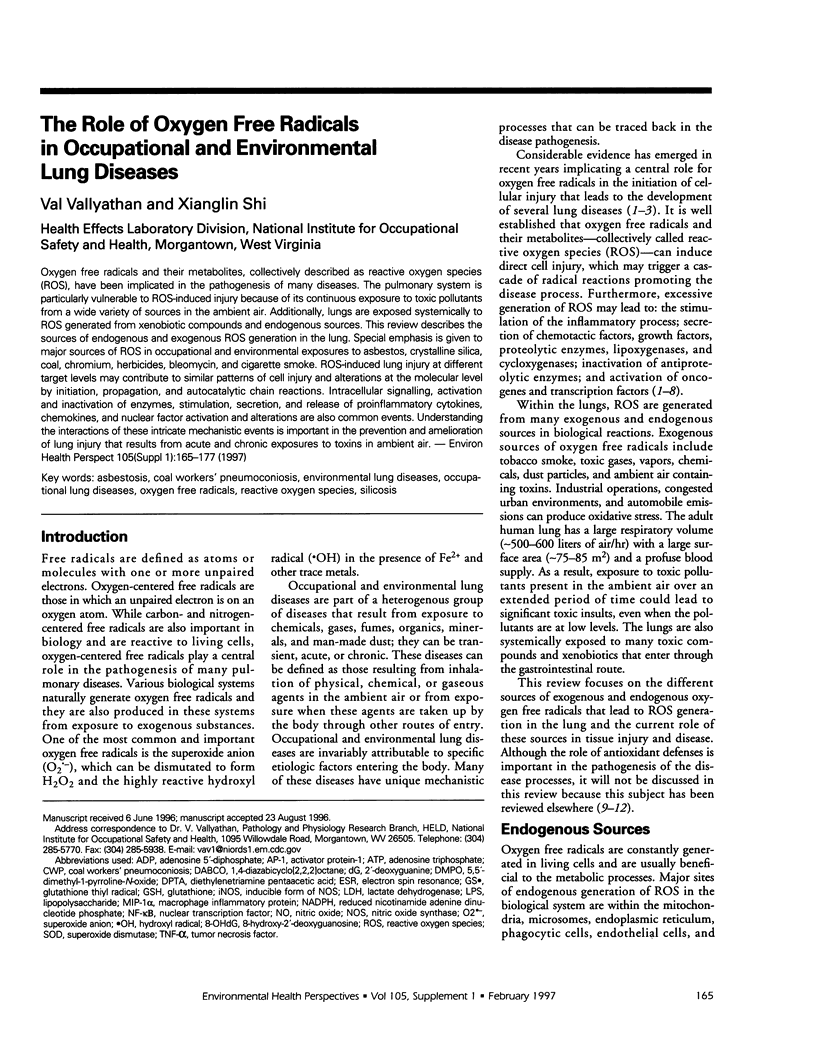
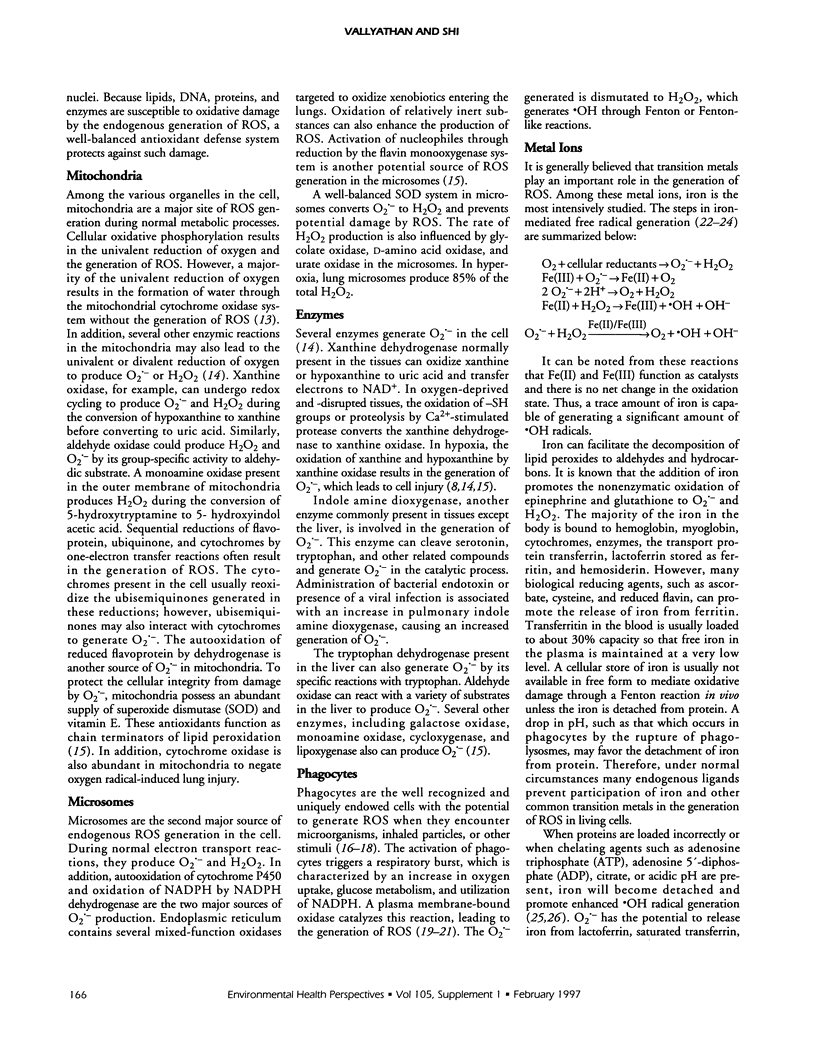
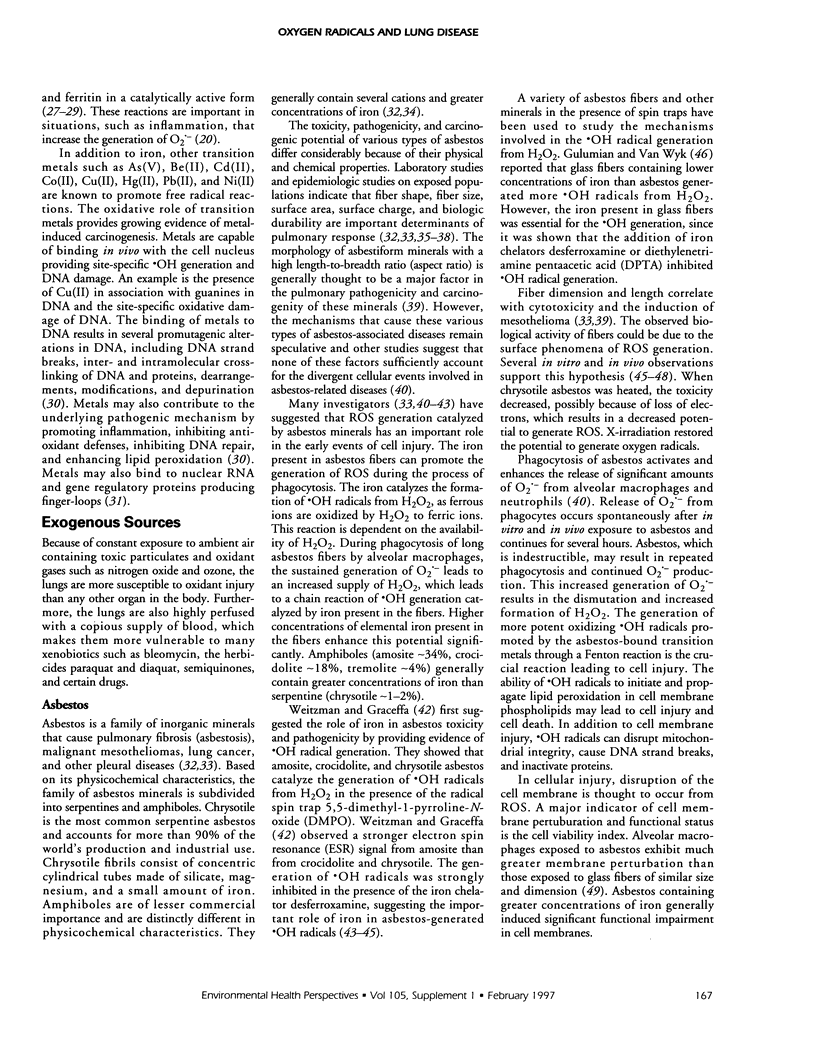
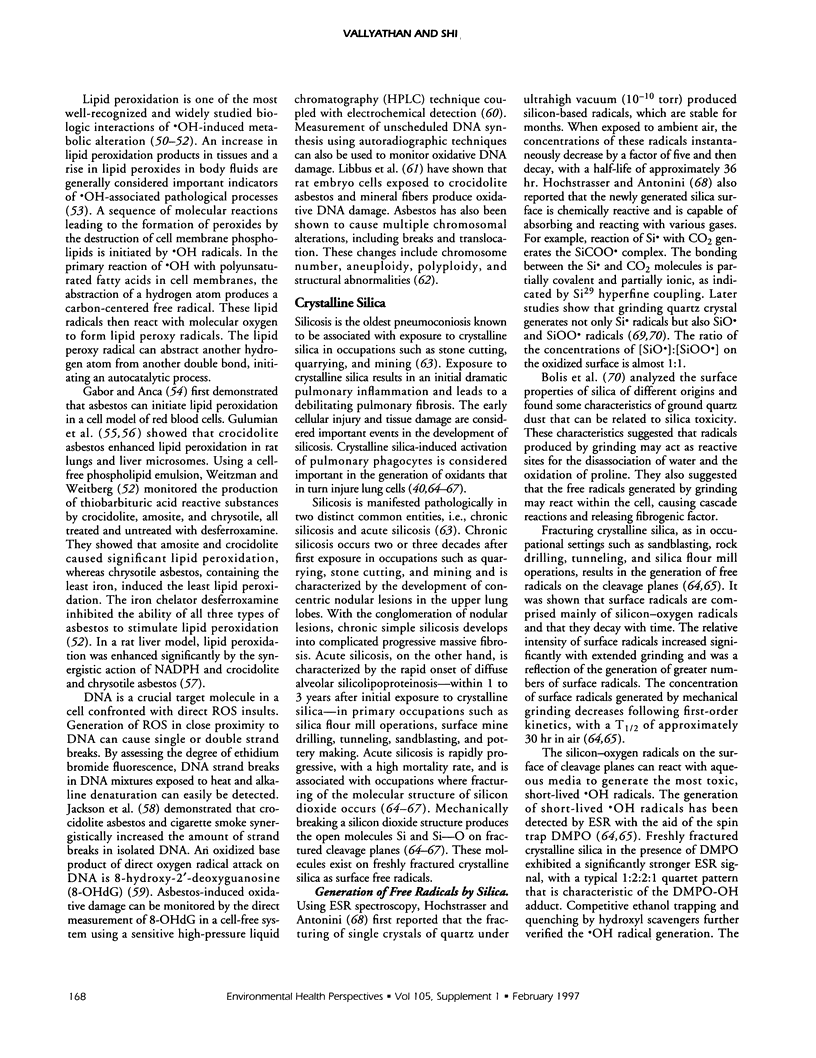
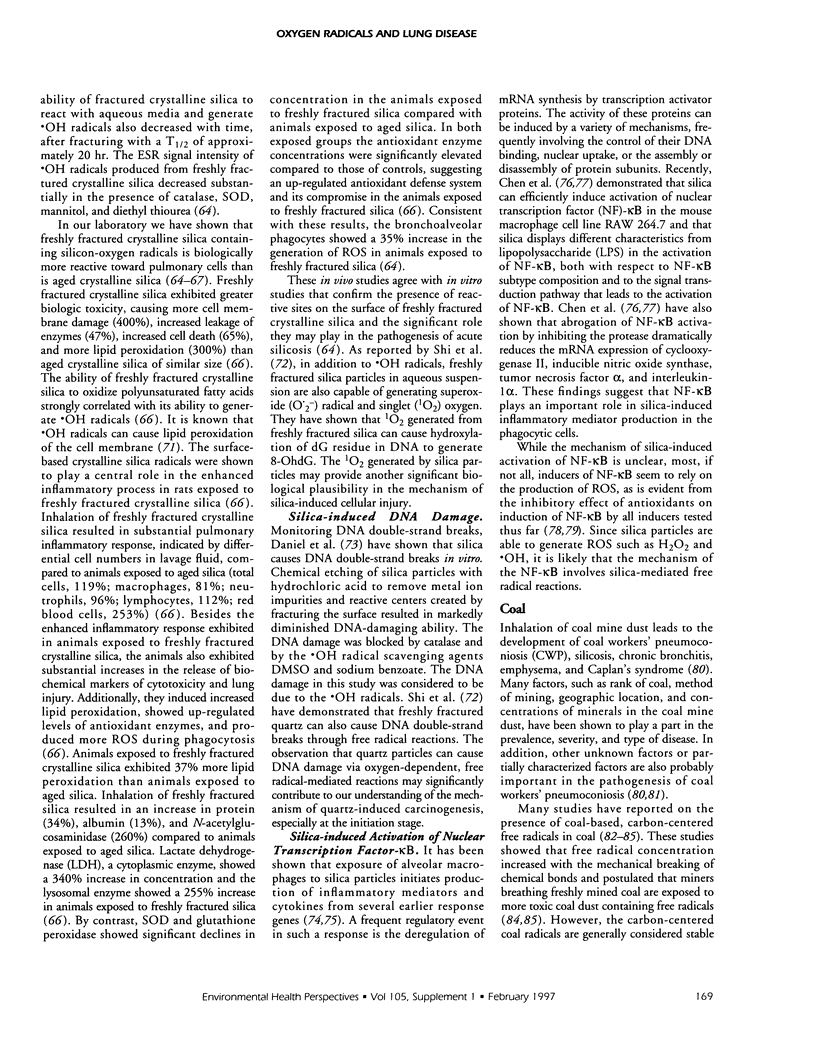
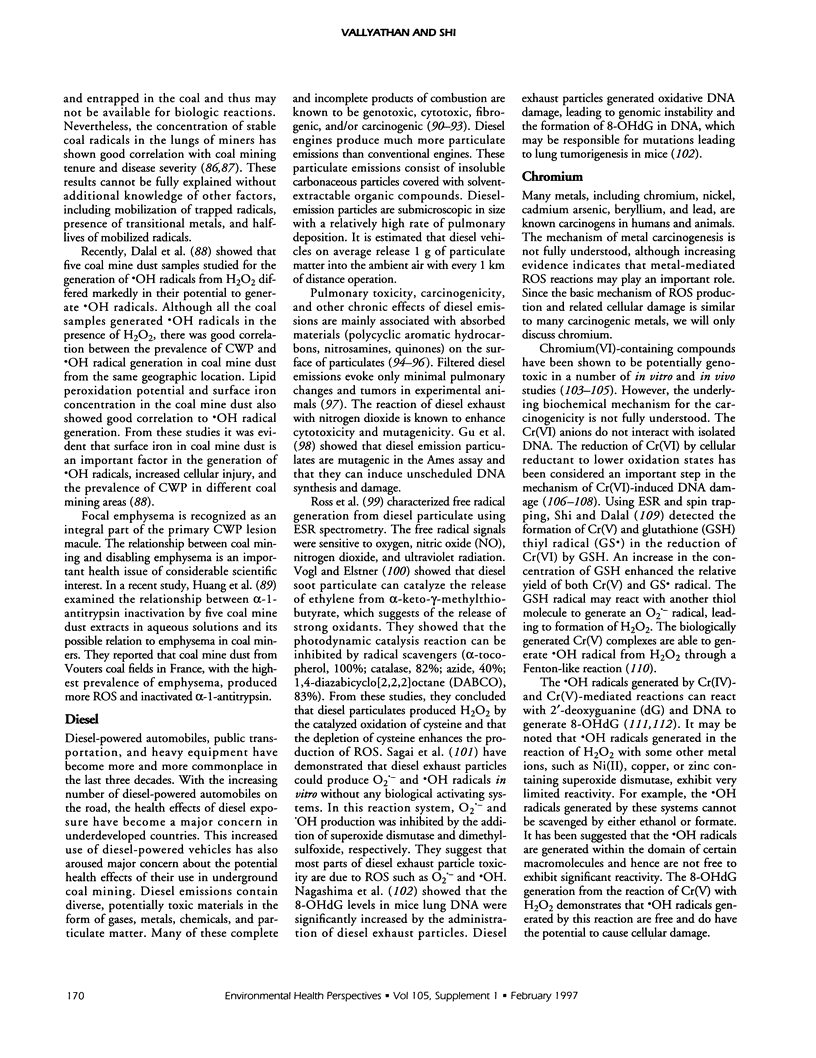
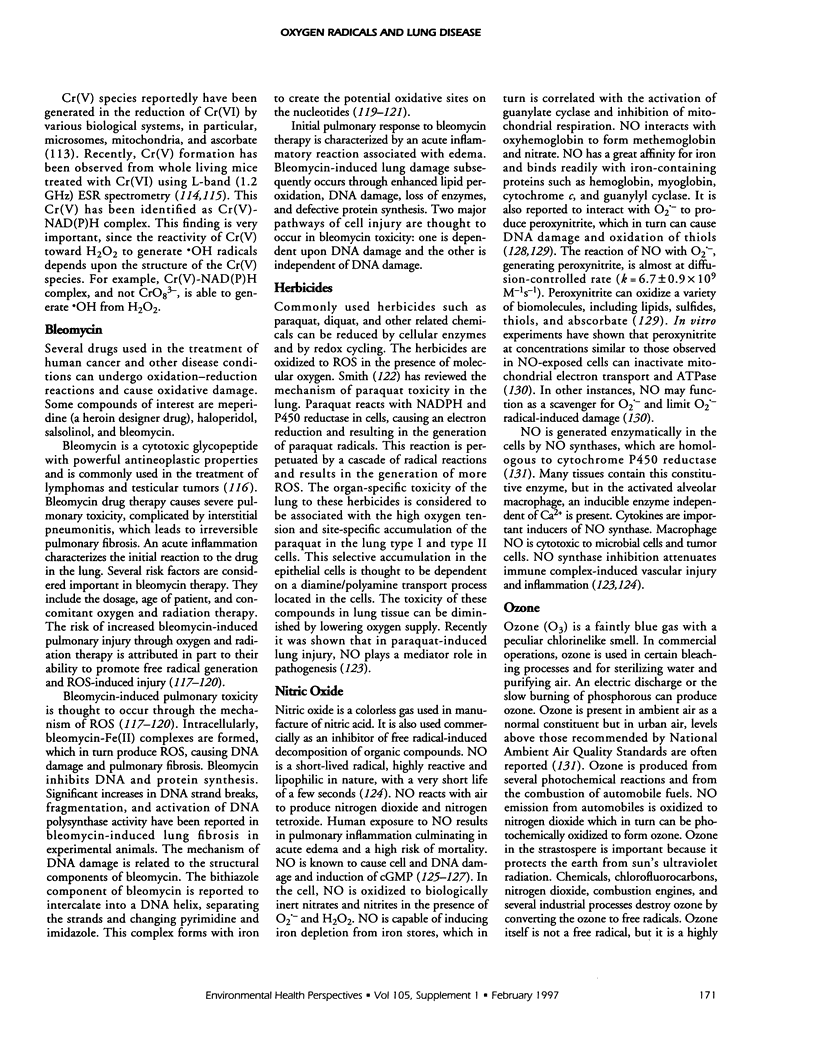
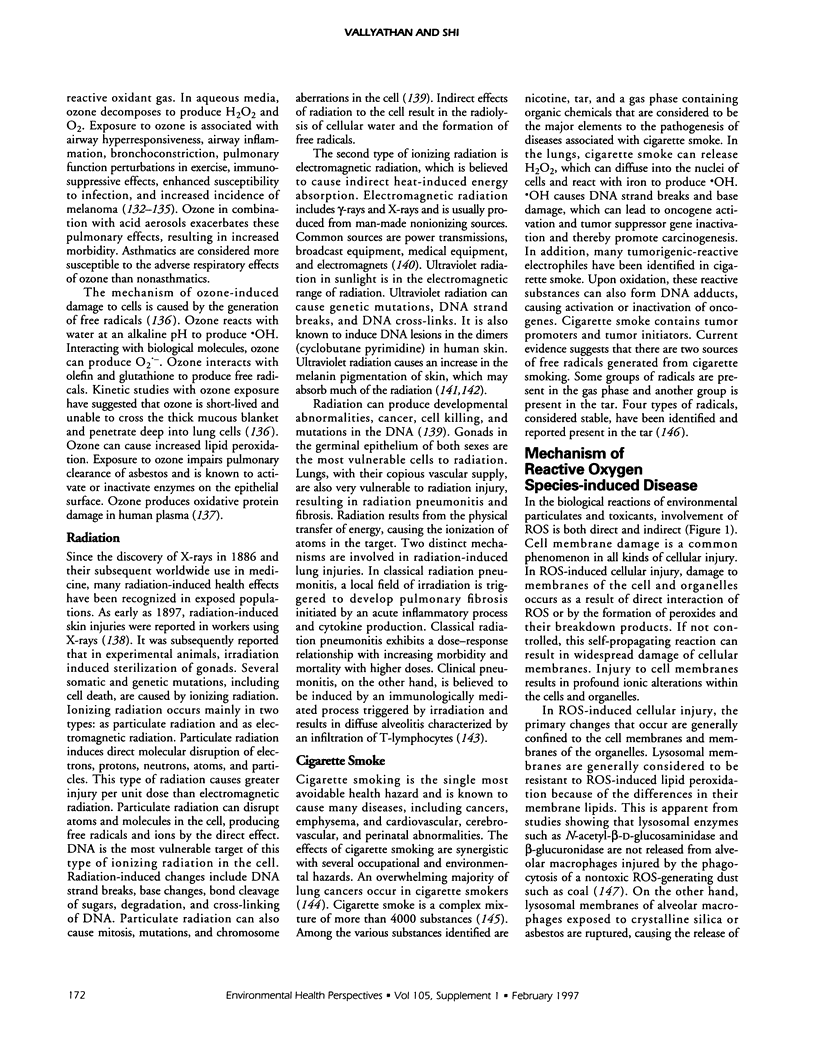
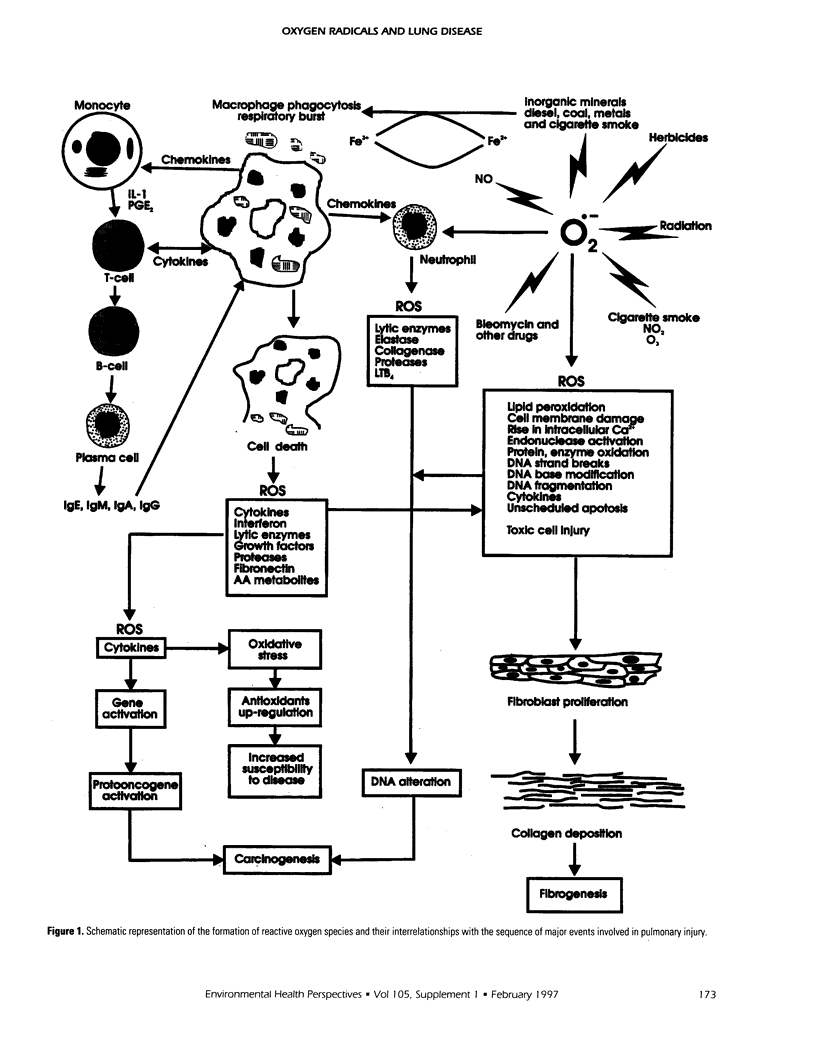
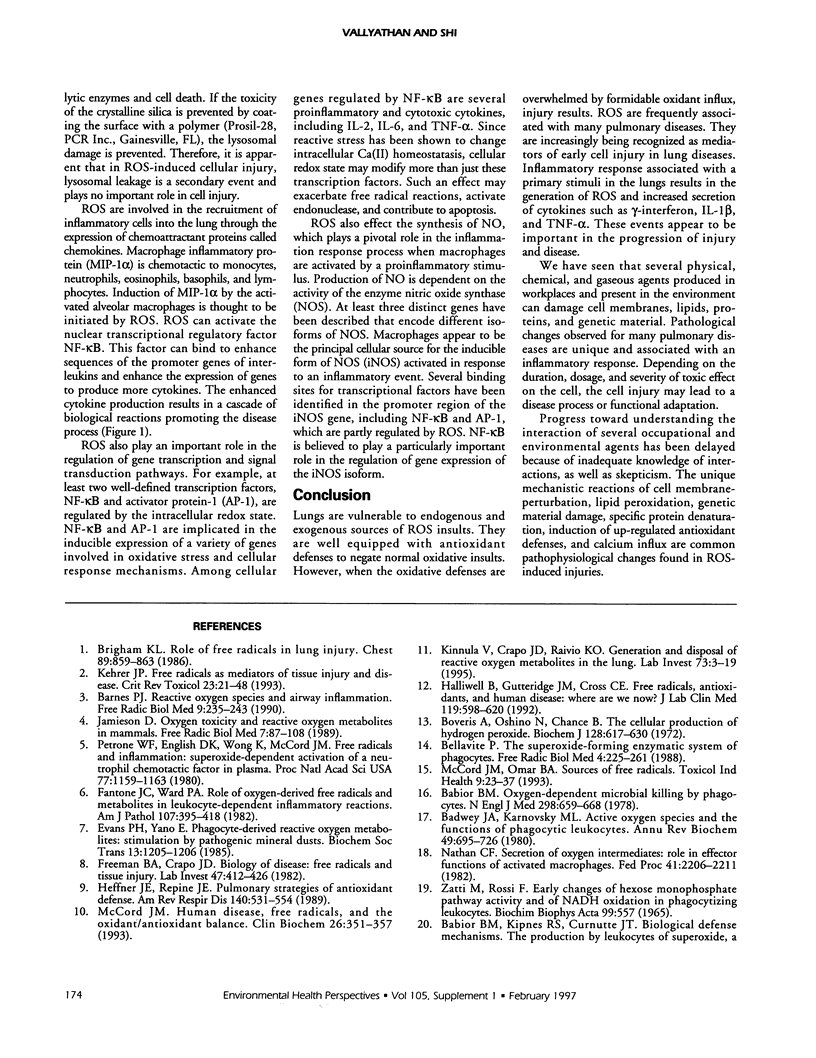
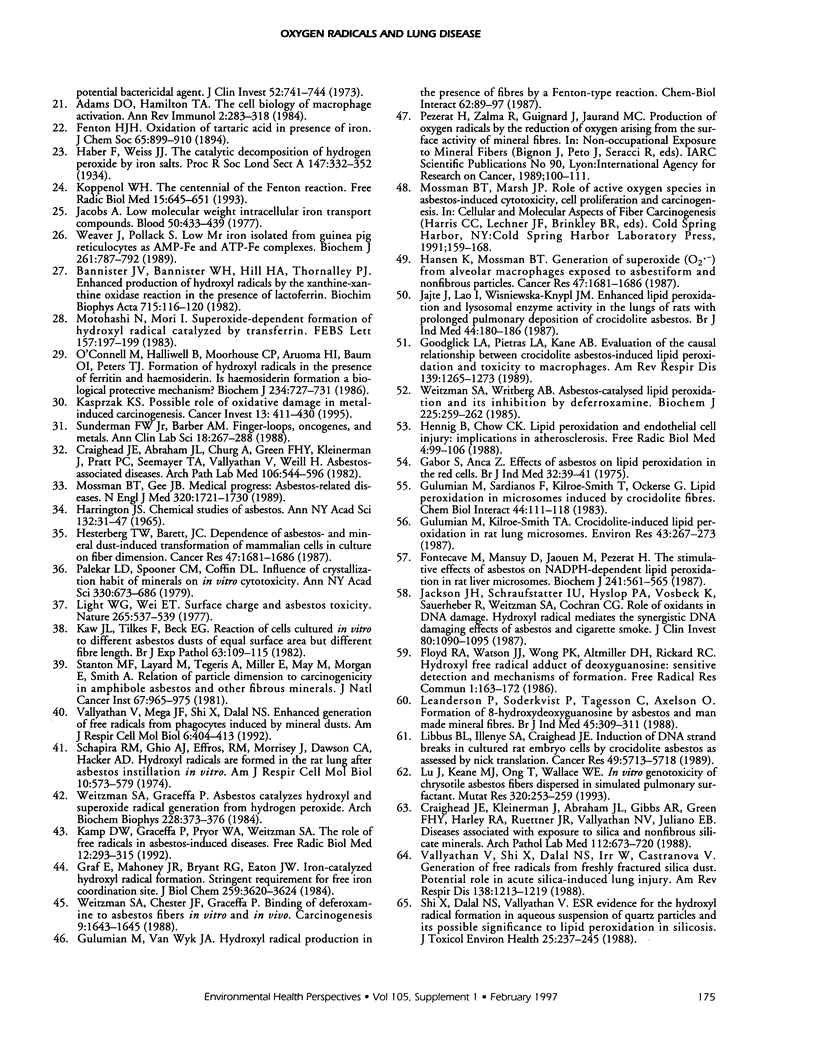
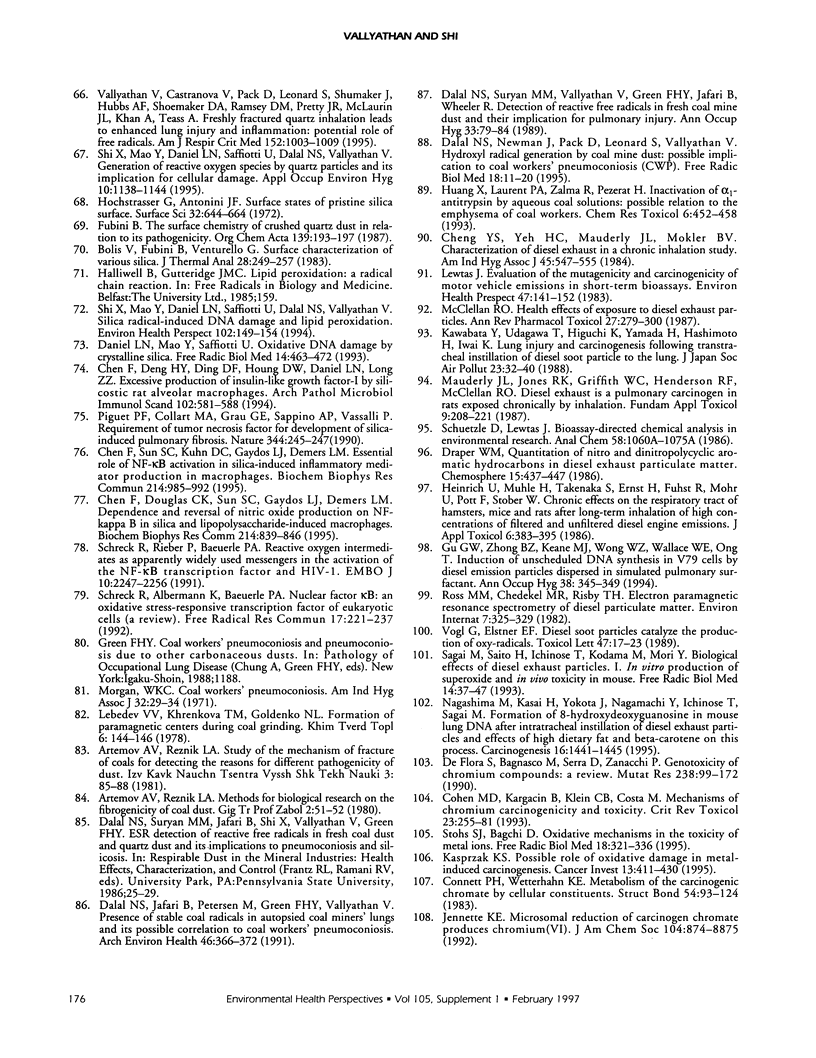
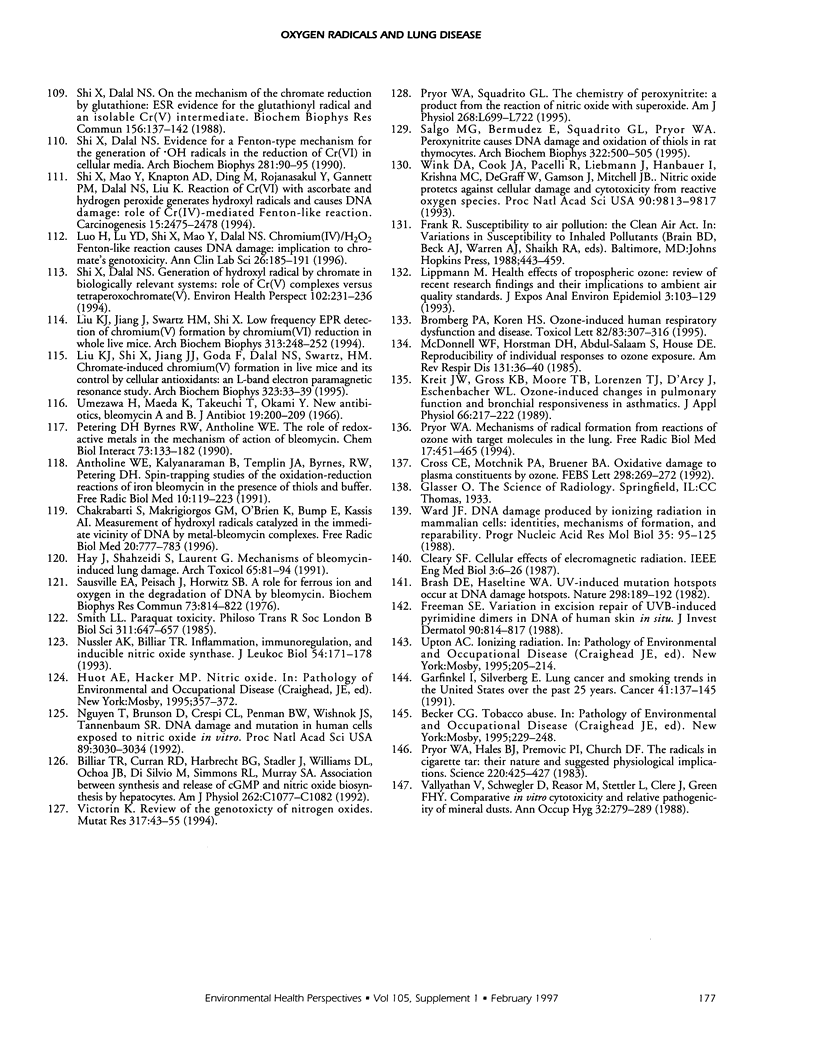
Selected References
These references are in PubMed. This may not be the complete list of references from this article.
- Adams D. O., Hamilton T. A. The cell biology of macrophage activation. Annu Rev Immunol. 1984;2:283–318. doi: 10.1146/annurev.iy.02.040184.001435. [DOI] [PubMed] [Google Scholar]
- Antholine W. E., Kalyanaraman B., Templin J. A., Byrnes R. W., Petering D. H. Spin-trapping studies of the oxidation-reduction reactions of iron bleomycin in the presence of thiols and buffer. Free Radic Biol Med. 1991;10(2):119–123. doi: 10.1016/0891-5849(91)90005-n. [DOI] [PubMed] [Google Scholar]
- Artemov A. V., Reznik L. A. K voprosu o metodike biologicheskikh issledovanii fibrogennosti ugol'noi pyli. Gig Tr Prof Zabol. 1980 Feb;(2):51–52. [PubMed] [Google Scholar]
- Babior B. M. Oxygen-dependent microbial killing by phagocytes (first of two parts). N Engl J Med. 1978 Mar 23;298(12):659–668. doi: 10.1056/NEJM197803232981205. [DOI] [PubMed] [Google Scholar]
- Badwey J. A., Karnovsky M. L. Active oxygen species and the functions of phagocytic leukocytes. Annu Rev Biochem. 1980;49:695–726. doi: 10.1146/annurev.bi.49.070180.003403. [DOI] [PubMed] [Google Scholar]
- Bannister J. V., Bannister W. H., Hill H. A., Thornalley P. J. Enhanced production of hydroxyl radicals by the xanthine-xanthine oxidase reaction in the presence of lactoferrin. Biochim Biophys Acta. 1982 Mar 15;715(1):116–120. doi: 10.1016/0304-4165(82)90056-3. [DOI] [PubMed] [Google Scholar]
- Barnes P. J. Reactive oxygen species and airway inflammation. Free Radic Biol Med. 1990;9(3):235–243. doi: 10.1016/0891-5849(90)90034-g. [DOI] [PubMed] [Google Scholar]
- Bellavite P. The superoxide-forming enzymatic system of phagocytes. Free Radic Biol Med. 1988;4(4):225–261. doi: 10.1016/0891-5849(88)90044-5. [DOI] [PubMed] [Google Scholar]
- Billiar T. R., Curran R. D., Harbrecht B. G., Stadler J., Williams D. L., Ochoa J. B., Di Silvio M., Simmons R. L., Murray S. A. Association between synthesis and release of cGMP and nitric oxide biosynthesis by hepatocytes. Am J Physiol. 1992 Apr;262(4 Pt 1):C1077–C1082. doi: 10.1152/ajpcell.1992.262.4.C1077. [DOI] [PubMed] [Google Scholar]
- Boveris A., Oshino N., Chance B. The cellular production of hydrogen peroxide. Biochem J. 1972 Jul;128(3):617–630. doi: 10.1042/bj1280617. [DOI] [PMC free article] [PubMed] [Google Scholar]
- Brash D. E., Haseltine W. A. UV-induced mutation hotspots occur at DNA damage hotspots. Nature. 1982 Jul 8;298(5870):189–192. doi: 10.1038/298189a0. [DOI] [PubMed] [Google Scholar]
- Brigham K. L. Role of free radicals in lung injury. Chest. 1986 Jun;89(6):859–863. doi: 10.1378/chest.89.6.859. [DOI] [PubMed] [Google Scholar]
- Bromberg P. A., Koren H. S. Ozone-induced human respiratory dysfunction and disease. Toxicol Lett. 1995 Dec;82-83:307–316. doi: 10.1016/0378-4274(95)03565-6. [DOI] [PubMed] [Google Scholar]
- Chakrabarti S., Makrigiorgos G. M., O'Brien K., Bump E., Kassis A. I. Measurement of hydroxyl radicals catalyzed in the immediate vicinity of DNA by metal-bleomycin complexes. Free Radic Biol Med. 1996;20(6):777–783. doi: 10.1016/0891-5849(95)02160-4. [DOI] [PubMed] [Google Scholar]
- Chen F., Deng H. Y., Ding G. F., Houng D. W., Deng Y. L., Long Z. Z. Excessive production of insulin-like growth factor-I by silicotic rat alveolar macrophages. APMIS. 1994 Aug;102(8):581–588. doi: 10.1111/j.1699-0463.1994.tb05207.x. [DOI] [PubMed] [Google Scholar]
- Chen F., Kuhn D. C., Sun S. C., Gaydos L. J., Demers L. M. Dependence and reversal of nitric oxide production on NF-kappa B in silica and lipopolysaccharide-induced macrophages. Biochem Biophys Res Commun. 1995 Sep 25;214(3):839–846. doi: 10.1006/bbrc.1995.2363. [DOI] [PubMed] [Google Scholar]
- Chen F., Sun S. C., Kuh D. C., Gaydos L. J., Demers L. M. Essential role of NF-kappa B activation in silica-induced inflammatory mediator production in macrophages. Biochem Biophys Res Commun. 1995 Sep 25;214(3):985–992. doi: 10.1006/bbrc.1995.2383. [DOI] [PubMed] [Google Scholar]
- Cheng Y. S., Yeh H. C., Mauderly J. L., Mokler B. V. Characterization of diesel exhaust in a chronic inhalation study. Am Ind Hyg Assoc J. 1984 Aug;45(8):547–555. doi: 10.1080/15298668491400241. [DOI] [PubMed] [Google Scholar]
- Cohen M. D., Kargacin B., Klein C. B., Costa M. Mechanisms of chromium carcinogenicity and toxicity. Crit Rev Toxicol. 1993;23(3):255–281. doi: 10.3109/10408449309105012. [DOI] [PubMed] [Google Scholar]
- Craighead J. E., Abraham J. L., Churg A., Green F. H., Kleinerman J., Pratt P. C., Seemayer T. A., Vallyathan V., Weill H. The pathology of asbestos-associated diseases of the lungs and pleural cavities: diagnostic criteria and proposed grading schema. Report of the Pneumoconiosis Committee of the College of American Pathologists and the National Institute for Occupational Safety and Health. Arch Pathol Lab Med. 1982 Oct 8;106(11):544–596. [PubMed] [Google Scholar]
- Cross C. E., Motchnik P. A., Bruener B. A., Jones D. A., Kaur H., Ames B. N., Halliwell B. Oxidative damage to plasma constituents by ozone. FEBS Lett. 1992 Feb 24;298(2-3):269–272. doi: 10.1016/0014-5793(92)80074-q. [DOI] [PubMed] [Google Scholar]
- Dalal N. S., Jafari B., Petersen M., Green F. H., Vallyathan V. Presence of stable coal radicals in autopsied coal miners' lungs and its possible correlation to coal workers' pneumoconiosis. Arch Environ Health. 1991 Nov-Dec;46(6):366–372. doi: 10.1080/00039896.1991.9934404. [DOI] [PubMed] [Google Scholar]
- Dalal N. S., Newman J., Pack D., Leonard S., Vallyathan V. Hydroxyl radical generation by coal mine dust: possible implication to coal workers' pneumoconiosis (CWP). Free Radic Biol Med. 1995 Jan;18(1):11–20. doi: 10.1016/0891-5849(94)e0094-y. [DOI] [PubMed] [Google Scholar]
- Dalal N. S., Suryan M. M., Vallyathan V., Green F. H., Jafari B., Wheeler R. Detection of reactive free radicals in fresh coal mine dust and their implication for pulmonary injury. Ann Occup Hyg. 1989;33(1):79–84. doi: 10.1093/annhyg/33.1.79. [DOI] [PubMed] [Google Scholar]
- Daniel L. N., Mao Y., Saffiotti U. Oxidative DNA damage by crystalline silica. Free Radic Biol Med. 1993 May;14(5):463–472. doi: 10.1016/0891-5849(93)90103-2. [DOI] [PubMed] [Google Scholar]
- De Flora S., Bagnasco M., Serra D., Zanacchi P. Genotoxicity of chromium compounds. A review. Mutat Res. 1990 Mar;238(2):99–172. doi: 10.1016/0165-1110(90)90007-x. [DOI] [PubMed] [Google Scholar]
- Diseases associated with exposure to silica and nonfibrous silicate minerals. Silicosis and Silicate Disease Committee. Arch Pathol Lab Med. 1988 Jul;112(7):673–720. [PubMed] [Google Scholar]
- Fantone J. C., Ward P. A. Role of oxygen-derived free radicals and metabolites in leukocyte-dependent inflammatory reactions. Am J Pathol. 1982 Jun;107(3):395–418. [PMC free article] [PubMed] [Google Scholar]
- Floyd R. A., Watson J. J., Wong P. K., Altmiller D. H., Rickard R. C. Hydroxyl free radical adduct of deoxyguanosine: sensitive detection and mechanisms of formation. Free Radic Res Commun. 1986;1(3):163–172. doi: 10.3109/10715768609083148. [DOI] [PubMed] [Google Scholar]
- Fontecave M., Mansuy D., Jaouen M., Pezerat H. The stimulatory effects of asbestos on NADPH-dependent lipid peroxidation in rat liver microsomes. Biochem J. 1987 Jan 15;241(2):561–565. doi: 10.1042/bj2410561. [DOI] [PMC free article] [PubMed] [Google Scholar]
- Freeman B. A., Crapo J. D. Biology of disease: free radicals and tissue injury. Lab Invest. 1982 Nov;47(5):412–426. [PubMed] [Google Scholar]
- Freeman S. E. Variations in excision repair of UVB-induced pyrimidine dimers in DNA of human skin in situ. J Invest Dermatol. 1988 Jun;90(6):814–817. doi: 10.1111/1523-1747.ep12462039. [DOI] [PubMed] [Google Scholar]
- Gabor S., Anca Z. Effect of asbestos on lipid peroxidation in the red cells. Br J Ind Med. 1975 Feb;32(1):39–41. doi: 10.1136/oem.32.1.39. [DOI] [PMC free article] [PubMed] [Google Scholar]
- Garfinkel L., Silverberg E. Lung cancer and smoking trends in the United States over the past 25 years. CA Cancer J Clin. 1991 May-Jun;41(3):137–145. doi: 10.3322/canjclin.41.3.137. [DOI] [PubMed] [Google Scholar]
- Goodglick L. A., Pietras L. A., Kane A. B. Evaluation of the causal relationship between crocidolite asbestos-induced lipid peroxidation and toxicity to macrophages. Am Rev Respir Dis. 1989 May;139(5):1265–1273. doi: 10.1164/ajrccm/139.5.1265. [DOI] [PubMed] [Google Scholar]
- Graf E., Mahoney J. R., Bryant R. G., Eaton J. W. Iron-catalyzed hydroxyl radical formation. Stringent requirement for free iron coordination site. J Biol Chem. 1984 Mar 25;259(6):3620–3624. [PubMed] [Google Scholar]
- Gulumian M., Kilroe-Smith T. A. Crocidolite-induced lipid peroxidation in rat lung microsomes. I. Role of different ions. Environ Res. 1987 Jun;43(1):267–273. doi: 10.1016/s0013-9351(87)80077-4. [DOI] [PubMed] [Google Scholar]
- Gulumian M., Sardianos F., Kilroe-Smith T., Ockerse G. Lipid peroxidation in microsomes induced by crocidolite fibres. Chem Biol Interact. 1983 Apr-May;44(1-2):111–118. doi: 10.1016/0009-2797(83)90133-3. [DOI] [PubMed] [Google Scholar]
- Gulumian M., van Wyk J. A. Hydroxyl radical production in the presence of fibres by a Fenton-type reaction. Chem Biol Interact. 1987;62(1):89–97. doi: 10.1016/0009-2797(87)90081-0. [DOI] [PubMed] [Google Scholar]
- Halliwell B., Gutteridge J. M., Cross C. E. Free radicals, antioxidants, and human disease: where are we now? J Lab Clin Med. 1992 Jun;119(6):598–620. [PubMed] [Google Scholar]
- Hansen K., Mossman B. T. Generation of superoxide (O2-.) from alveolar macrophages exposed to asbestiform and nonfibrous particles. Cancer Res. 1987 Mar 15;47(6):1681–1686. [PubMed] [Google Scholar]
- Hansen K., Mossman B. T. Generation of superoxide (O2-.) from alveolar macrophages exposed to asbestiform and nonfibrous particles. Cancer Res. 1987 Mar 15;47(6):1681–1686. [PubMed] [Google Scholar]
- Harington J. S. Chemical studies of asbestos. Ann N Y Acad Sci. 1965 Dec 31;132(1):31–47. doi: 10.1111/j.1749-6632.1965.tb41088.x. [DOI] [PubMed] [Google Scholar]
- Hay J., Shahzeidi S., Laurent G. Mechanisms of bleomycin-induced lung damage. Arch Toxicol. 1991;65(2):81–94. doi: 10.1007/BF02034932. [DOI] [PubMed] [Google Scholar]
- Heffner J. E., Repine J. E. Pulmonary strategies of antioxidant defense. Am Rev Respir Dis. 1989 Aug;140(2):531–554. doi: 10.1164/ajrccm/140.2.531. [DOI] [PubMed] [Google Scholar]
- Heinrich U., Muhle H., Takenaka S., Ernst H., Fuhst R., Mohr U., Pott F., Stöber W. Chronic effects on the respiratory tract of hamsters, mice and rats after long-term inhalation of high concentrations of filtered and unfiltered diesel engine emissions. J Appl Toxicol. 1986 Dec;6(6):383–395. doi: 10.1002/jat.2550060602. [DOI] [PubMed] [Google Scholar]
- Hennig B., Chow C. K. Lipid peroxidation and endothelial cell injury: implications in atherosclerosis. Free Radic Biol Med. 1988;4(2):99–106. doi: 10.1016/0891-5849(88)90070-6. [DOI] [PubMed] [Google Scholar]
- Huang X., Laurent P. A., Zalma R., Pezerat H. Inactivation of alpha 1-antitrypsin by aqueous coal solutions: possible relation to the emphysema of coal workers. Chem Res Toxicol. 1993 Jul-Aug;6(4):452–458. doi: 10.1021/tx00034a011. [DOI] [PubMed] [Google Scholar]
- Jackson J. H., Schraufstatter I. U., Hyslop P. A., Vosbeck K., Sauerheber R., Weitzman S. A., Cochrane C. G. Role of oxidants in DNA damage. Hydroxyl radical mediates the synergistic DNA damaging effects of asbestos and cigarette smoke. J Clin Invest. 1987 Oct;80(4):1090–1095. doi: 10.1172/JCI113165. [DOI] [PMC free article] [PubMed] [Google Scholar]
- Jacobs A. Low molecular weight intracellular iron transport compounds. Blood. 1977 Sep;50(3):433–439. [PubMed] [Google Scholar]
- Jajte J., Lao I., Wiśniewska-Knypl J. M. Enhanced lipid peroxidation and lysosomal enzyme activity in the lungs of rats with prolonged pulmonary deposition of crocidolite asbestos. Br J Ind Med. 1987 Mar;44(3):180–186. doi: 10.1136/oem.44.3.180. [DOI] [PMC free article] [PubMed] [Google Scholar]
- Jamieson D. Oxygen toxicity and reactive oxygen metabolites in mammals. Free Radic Biol Med. 1989;7(1):87–108. doi: 10.1016/0891-5849(89)90103-2. [DOI] [PubMed] [Google Scholar]
- Kamp D. W., Graceffa P., Pryor W. A., Weitzman S. A. The role of free radicals in asbestos-induced diseases. Free Radic Biol Med. 1992;12(4):293–315. doi: 10.1016/0891-5849(92)90117-y. [DOI] [PubMed] [Google Scholar]
- Kasprzak K. S. Possible role of oxidative damage in metal-induced carcinogenesis. Cancer Invest. 1995;13(4):411–430. doi: 10.3109/07357909509031921. [DOI] [PubMed] [Google Scholar]
- Kasprzak K. S. Possible role of oxidative damage in metal-induced carcinogenesis. Cancer Invest. 1995;13(4):411–430. doi: 10.3109/07357909509031921. [DOI] [PubMed] [Google Scholar]
- Kaw J. L., Tilkes F., Beck E. G. Reaction of cells cultured in vitro to different asbestos dusts of equal surface area but different fibre length. Br J Exp Pathol. 1982 Feb;63(1):109–115. [PMC free article] [PubMed] [Google Scholar]
- Kehrer J. P. Free radicals as mediators of tissue injury and disease. Crit Rev Toxicol. 1993;23(1):21–48. doi: 10.3109/10408449309104073. [DOI] [PubMed] [Google Scholar]
- Kinnula V. L., Crapo J. D., Raivio K. O. Generation and disposal of reactive oxygen metabolites in the lung. Lab Invest. 1995 Jul;73(1):3–19. [PubMed] [Google Scholar]
- Koppenol W. H. The centennial of the Fenton reaction. Free Radic Biol Med. 1993 Dec;15(6):645–651. doi: 10.1016/0891-5849(93)90168-t. [DOI] [PubMed] [Google Scholar]
- Kreit J. W., Gross K. B., Moore T. B., Lorenzen T. J., D'Arcy J., Eschenbacher W. L. Ozone-induced changes in pulmonary function and bronchial responsiveness in asthmatics. J Appl Physiol (1985) 1989 Jan;66(1):217–222. doi: 10.1152/jappl.1989.66.1.217. [DOI] [PubMed] [Google Scholar]
- Leanderson P., Söderkvist P., Tagesson C., Axelson O. Formation of 8-hydroxydeoxyguanosine by asbestos and man made mineral fibres. Br J Ind Med. 1988 May;45(5):309–311. doi: 10.1136/oem.45.5.309. [DOI] [PMC free article] [PubMed] [Google Scholar]
- Lewtas J. Evaluation of the mutagenicity and carcinogenicity of motor vehicle emissions in short-term bioassays. Environ Health Perspect. 1983 Jan;47:141–152. doi: 10.1289/ehp.8347141. [DOI] [PMC free article] [PubMed] [Google Scholar]
- Libbus B. L., Illenye S. A., Craighead J. E. Induction of DNA strand breaks in cultured rat embryo cells by crocidolite asbestos as assessed by nick translation. Cancer Res. 1989 Oct 15;49(20):5713–5718. [PubMed] [Google Scholar]
- Light W. G., Wei E. T. Surface charge and asbestos toxicity. Nature. 1977 Feb 10;265(5594):537–539. doi: 10.1038/265537a0. [DOI] [PubMed] [Google Scholar]
- Lippmann M. Health effects of tropospheric ozone: review of recent research findings and their implications to ambient air quality standards. J Expo Anal Environ Epidemiol. 1993 Jan-Mar;3(1):103–129. [PubMed] [Google Scholar]
- Liu K. J., Jiang J., Swartz H. M., Shi X. Low-frequency EPR detection of chromium(V) formation by chromium(VI) reduction in whole live mice. Arch Biochem Biophys. 1994 Sep;313(2):248–252. doi: 10.1006/abbi.1994.1384. [DOI] [PubMed] [Google Scholar]
- Liu K. J., Shi X., Jiang J. J., Goda F., Dalal N., Swartz H. M. Chromate-induced chromium(V) formation in live mice and its control by cellular antioxidants: an L-band electron paramagnetic resonance study. Arch Biochem Biophys. 1995 Oct 20;323(1):33–39. doi: 10.1006/abbi.1995.0006. [DOI] [PubMed] [Google Scholar]
- Lu J., Keane M. J., Ong T., Wallace W. E. In vitro genotoxicity studies of chrysotile asbestos fibers dispersed in simulated pulmonary surfactant. Mutat Res. 1994 Mar;320(4):253–259. doi: 10.1016/0165-1218(94)90078-7. [DOI] [PubMed] [Google Scholar]
- Luo H., Lu Y., Shi X., Mao Y., Dalal N. S. Chromium (IV)-mediated fenton-like reaction causes DNA damage: implication to genotoxicity of chromate. Ann Clin Lab Sci. 1996 Mar-Apr;26(2):185–191. [PubMed] [Google Scholar]
- Mauderly J. L., Jones R. K., Griffith W. C., Henderson R. F., McClellan R. O. Diesel exhaust is a pulmonary carcinogen in rats exposed chronically by inhalation. Fundam Appl Toxicol. 1987 Aug;9(2):208–221. doi: 10.1016/0272-0590(87)90044-3. [DOI] [PubMed] [Google Scholar]
- McClellan R. O. Health effects of exposure to diesel exhaust particles. Annu Rev Pharmacol Toxicol. 1987;27:279–300. doi: 10.1146/annurev.pa.27.040187.001431. [DOI] [PubMed] [Google Scholar]
- McCord J. M. Human disease, free radicals, and the oxidant/antioxidant balance. Clin Biochem. 1993 Oct;26(5):351–357. doi: 10.1016/0009-9120(93)90111-i. [DOI] [PubMed] [Google Scholar]
- McCord J. M., Omar B. A. Sources of free radicals. Toxicol Ind Health. 1993 Jan-Apr;9(1-2):23–37. doi: 10.1177/0748233793009001-204. [DOI] [PubMed] [Google Scholar]
- McDonnell W. F., 3rd, Horstman D. H., Abdul-Salaam S., House D. E. Reproducibility of individual responses to ozone exposure. Am Rev Respir Dis. 1985 Jan;131(1):36–40. doi: 10.1164/arrd.1985.131.S5.S36. [DOI] [PubMed] [Google Scholar]
- Morgan W. K. Coal worker's pneumoconiosis. Am Ind Hyg Assoc J. 1971 Jan;32(1):29–34. doi: 10.1080/0002889718506403. [DOI] [PubMed] [Google Scholar]
- Mossman B. T., Gee J. B. Asbestos-related diseases. N Engl J Med. 1989 Jun 29;320(26):1721–1730. doi: 10.1056/NEJM198906293202604. [DOI] [PubMed] [Google Scholar]
- Motohashi N., Mori I. Superoxide-dependent formation of hydroxyl radical catalyzed by transferrin. FEBS Lett. 1983 Jun 27;157(1):197–199. doi: 10.1016/0014-5793(83)81144-2. [DOI] [PubMed] [Google Scholar]
- Nagashima M., Kasai H., Yokota J., Nagamachi Y., Ichinose T., Sagai M. Formation of an oxidative DNA damage, 8-hydroxydeoxyguanosine, in mouse lung DNA after intratracheal instillation of diesel exhaust particles and effects of high dietary fat and beta-carotene on this process. Carcinogenesis. 1995 Jun;16(6):1441–1445. doi: 10.1093/carcin/16.6.1441. [DOI] [PubMed] [Google Scholar]
- Nathan C. F. Secretion of oxygen intermediates: role in effector functions of activated macrophages. Fed Proc. 1982 Apr;41(6):2206–2211. [PubMed] [Google Scholar]
- Nguyen T., Brunson D., Crespi C. L., Penman B. W., Wishnok J. S., Tannenbaum S. R. DNA damage and mutation in human cells exposed to nitric oxide in vitro. Proc Natl Acad Sci U S A. 1992 Apr 1;89(7):3030–3034. doi: 10.1073/pnas.89.7.3030. [DOI] [PMC free article] [PubMed] [Google Scholar]
- Nussler A. K., Billiar T. R. Inflammation, immunoregulation, and inducible nitric oxide synthase. J Leukoc Biol. 1993 Aug;54(2):171–178. [PubMed] [Google Scholar]
- O'Connell M., Halliwell B., Moorhouse C. P., Aruoma O. I., Baum H., Peters T. J. Formation of hydroxyl radicals in the presence of ferritin and haemosiderin. Is haemosiderin formation a biological protective mechanism? Biochem J. 1986 Mar 15;234(3):727–731. doi: 10.1042/bj2340727. [DOI] [PMC free article] [PubMed] [Google Scholar]
- Palekar L. D., Spooner C. M., Coffin D. L. Influence of crystallization habit of minerals on in vitro cytotoxicity. Ann N Y Acad Sci. 1979;330:673–686. doi: 10.1111/j.1749-6632.1979.tb18771.x. [DOI] [PubMed] [Google Scholar]
- Petering D. H., Byrnes R. W., Antholine W. E. The role of redox-active metals in the mechanism of action of bleomycin. Chem Biol Interact. 1990;73(2-3):133–182. doi: 10.1016/0009-2797(90)90001-4. [DOI] [PubMed] [Google Scholar]
- Petrone W. F., English D. K., Wong K., McCord J. M. Free radicals and inflammation: superoxide-dependent activation of a neutrophil chemotactic factor in plasma. Proc Natl Acad Sci U S A. 1980 Feb;77(2):1159–1163. doi: 10.1073/pnas.77.2.1159. [DOI] [PMC free article] [PubMed] [Google Scholar]
- Pezerat H., Zalma R., Guignard J., Jaurand M. C. Production of oxygen radicals by the reduction of oxygen arising from the surface activity of mineral fibres. IARC Sci Publ. 1989;(90):100–111. [PubMed] [Google Scholar]
- Piguet P. F., Collart M. A., Grau G. E., Sappino A. P., Vassalli P. Requirement of tumour necrosis factor for development of silica-induced pulmonary fibrosis. Nature. 1990 Mar 15;344(6263):245–247. doi: 10.1038/344245a0. [DOI] [PubMed] [Google Scholar]
- Pryor W. A., Hales B. J., Premovic P. I., Church D. F. The radicals in cigarette tar: their nature and suggested physiological implications. Science. 1983 Apr 22;220(4595):425–427. doi: 10.1126/science.6301009. [DOI] [PubMed] [Google Scholar]
- Pryor W. A. Mechanisms of radical formation from reactions of ozone with target molecules in the lung. Free Radic Biol Med. 1994 Nov;17(5):451–465. doi: 10.1016/0891-5849(94)90172-4. [DOI] [PubMed] [Google Scholar]
- Pryor W. A., Squadrito G. L. The chemistry of peroxynitrite: a product from the reaction of nitric oxide with superoxide. Am J Physiol. 1995 May;268(5 Pt 1):L699–L722. doi: 10.1152/ajplung.1995.268.5.L699. [DOI] [PubMed] [Google Scholar]
- Sagai M., Saito H., Ichinose T., Kodama M., Mori Y. Biological effects of diesel exhaust particles. I. In vitro production of superoxide and in vivo toxicity in mouse. Free Radic Biol Med. 1993 Jan;14(1):37–47. doi: 10.1016/0891-5849(93)90507-q. [DOI] [PubMed] [Google Scholar]
- Salgo M. G., Bermúdez E., Squadrito G. L., Pryor W. A. Peroxynitrite causes DNA damage and oxidation of thiols in rat thymocytes [corrected]. Arch Biochem Biophys. 1995 Oct 1;322(2):500–505. doi: 10.1006/abbi.1995.1493. [DOI] [PubMed] [Google Scholar]
- Sausville E. A., Peisach J., Horwitz S. B. A role for ferrous ion and oxygen in the degradation of DNA by bleomycin. Biochem Biophys Res Commun. 1976 Dec 6;73(3):814–822. doi: 10.1016/0006-291x(76)90882-2. [DOI] [PubMed] [Google Scholar]
- Schapira R. M., Ghio A. J., Effros R. M., Morrisey J., Dawson C. A., Hacker A. D. Hydroxyl radicals are formed in the rat lung after asbestos instillation in vivo. Am J Respir Cell Mol Biol. 1994 May;10(5):573–579. doi: 10.1165/ajrcmb.10.5.8179922. [DOI] [PubMed] [Google Scholar]
- Schreck R., Albermann K., Baeuerle P. A. Nuclear factor kappa B: an oxidative stress-responsive transcription factor of eukaryotic cells (a review). Free Radic Res Commun. 1992;17(4):221–237. doi: 10.3109/10715769209079515. [DOI] [PubMed] [Google Scholar]
- Schreck R., Rieber P., Baeuerle P. A. Reactive oxygen intermediates as apparently widely used messengers in the activation of the NF-kappa B transcription factor and HIV-1. EMBO J. 1991 Aug;10(8):2247–2258. doi: 10.1002/j.1460-2075.1991.tb07761.x. [DOI] [PMC free article] [PubMed] [Google Scholar]
- Schuetzle D., Lewtas J. Bioassay-directed chemical analysis in environmental research. Anal Chem. 1986 Sep;58(11):1060A–1075A. doi: 10.1021/ac00124a001. [DOI] [PubMed] [Google Scholar]
- Shi X. L., Dalal N. S. Evidence for a Fenton-type mechanism for the generation of .OH radicals in the reduction of Cr(VI) in cellular media. Arch Biochem Biophys. 1990 Aug 15;281(1):90–95. doi: 10.1016/0003-9861(90)90417-w. [DOI] [PubMed] [Google Scholar]
- Shi X. L., Dalal N. S. On the mechanism of the chromate reduction by glutathione: ESR evidence for the glutathionyl radical and an isolable Cr(V) intermediate. Biochem Biophys Res Commun. 1988 Oct 14;156(1):137–142. doi: 10.1016/s0006-291x(88)80815-5. [DOI] [PubMed] [Google Scholar]
- Shi X. L., Dalal N. S., Vallyathan V. ESR evidence for the hydroxyl radical formation in aqueous suspension of quartz particles and its possible significance to lipid peroxidation in silicosis. J Toxicol Environ Health. 1988;25(2):237–245. doi: 10.1080/15287398809531205. [DOI] [PubMed] [Google Scholar]
- Shi X., Dalal N. S. Generation of hydroxyl radical by chromate in biologically relevant systems: role of Cr(V) complexes versus tetraperoxochromate(V). Environ Health Perspect. 1994 Sep;102 (Suppl 3):231–236. doi: 10.1289/ehp.94102s3231. [DOI] [PMC free article] [PubMed] [Google Scholar]
- Shi X., Mao Y., Daniel L. N., Saffiotti U., Dalal N. S., Vallyathan V. Silica radical-induced DNA damage and lipid peroxidation. Environ Health Perspect. 1994 Dec;102 (Suppl 10):149–154. doi: 10.1289/ehp.94102s10149. [DOI] [PMC free article] [PubMed] [Google Scholar]
- Shi X., Mao Y., Knapton A. D., Ding M., Rojanasakul Y., Gannett P. M., Dalal N., Liu K. Reaction of Cr(VI) with ascorbate and hydrogen peroxide generates hydroxyl radicals and causes DNA damage: role of a Cr(IV)-mediated Fenton-like reaction. Carcinogenesis. 1994 Nov;15(11):2475–2478. doi: 10.1093/carcin/15.11.2475. [DOI] [PubMed] [Google Scholar]
- Smith L. L. Paraquat toxicity. Philos Trans R Soc Lond B Biol Sci. 1985 Dec 17;311(1152):647–657. doi: 10.1098/rstb.1985.0170. [DOI] [PubMed] [Google Scholar]
- Stanton M. F., Layard M., Tegeris A., Miller E., May M., Morgan E., Smith A. Relation of particle dimension to carcinogenicity in amphibole asbestoses and other fibrous minerals. J Natl Cancer Inst. 1981 Nov;67(5):965–975. [PubMed] [Google Scholar]
- Stohs S. J., Bagchi D. Oxidative mechanisms in the toxicity of metal ions. Free Radic Biol Med. 1995 Feb;18(2):321–336. doi: 10.1016/0891-5849(94)00159-h. [DOI] [PubMed] [Google Scholar]
- Sunderman F. W., Jr, Barber A. M. Finger-loops, oncogenes, and metals. Claude Passmore Brown memorial lecture. Ann Clin Lab Sci. 1988 Jul-Aug;18(4):267–288. [PubMed] [Google Scholar]
- Umezawa H., Maeda K., Takeuchi T., Okami Y. New antibiotics, bleomycin A and B. J Antibiot (Tokyo) 1966 Sep;19(5):200–209. [PubMed] [Google Scholar]
- Vallyathan V., Castranova V., Pack D., Leonard S., Shumaker J., Hubbs A. F., Shoemaker D. A., Ramsey D. M., Pretty J. R., McLaurin J. L. Freshly fractured quartz inhalation leads to enhanced lung injury and inflammation. Potential role of free radicals. Am J Respir Crit Care Med. 1995 Sep;152(3):1003–1009. doi: 10.1164/ajrccm.152.3.7663775. [DOI] [PubMed] [Google Scholar]
- Vallyathan V., Mega J. F., Shi X., Dalal N. S. Enhanced generation of free radicals from phagocytes induced by mineral dusts. Am J Respir Cell Mol Biol. 1992 Apr;6(4):404–413. doi: 10.1165/ajrcmb/6.4.404. [DOI] [PubMed] [Google Scholar]
- Vallyathan V., Shi X. L., Dalal N. S., Irr W., Castranova V. Generation of free radicals from freshly fractured silica dust. Potential role in acute silica-induced lung injury. Am Rev Respir Dis. 1988 Nov;138(5):1213–1219. doi: 10.1164/ajrccm/138.5.1213. [DOI] [PubMed] [Google Scholar]
- Victorin K. Review of the genotoxicity of nitrogen oxides. Mutat Res. 1994 Feb;317(1):43–55. doi: 10.1016/0165-1110(94)90011-6. [DOI] [PubMed] [Google Scholar]
- Vogl G., Elstner E. F. Diesel soot particles catalyze the production of oxy-radicals. Toxicol Lett. 1989 Apr;47(1):17–23. doi: 10.1016/0378-4274(89)90082-9. [DOI] [PubMed] [Google Scholar]
- Ward J. F. DNA damage produced by ionizing radiation in mammalian cells: identities, mechanisms of formation, and reparability. Prog Nucleic Acid Res Mol Biol. 1988;35:95–125. doi: 10.1016/s0079-6603(08)60611-x. [DOI] [PubMed] [Google Scholar]
- Weaver J., Pollack S. Low-Mr iron isolated from guinea pig reticulocytes as AMP-Fe and ATP-Fe complexes. Biochem J. 1989 Aug 1;261(3):787–792. doi: 10.1042/bj2610787. [DOI] [PMC free article] [PubMed] [Google Scholar]
- Weitzman S. A., Chester J. F., Graceffa P. Binding of deferoxamine to asbestos fibers in vitro and in vivo. Carcinogenesis. 1988 Sep;9(9):1643–1645. doi: 10.1093/carcin/9.9.1643. [DOI] [PubMed] [Google Scholar]
- Weitzman S. A., Graceffa P. Asbestos catalyzes hydroxyl and superoxide radical generation from hydrogen peroxide. Arch Biochem Biophys. 1984 Jan;228(1):373–376. doi: 10.1016/0003-9861(84)90078-x. [DOI] [PubMed] [Google Scholar]
- Weitzman S. A., Weitberg A. B. Asbestos-catalysed lipid peroxidation and its inhibition by desferroxamine. Biochem J. 1985 Jan 1;225(1):259–262. doi: 10.1042/bj2250259. [DOI] [PMC free article] [PubMed] [Google Scholar]
- Wink D. A., Hanbauer I., Krishna M. C., DeGraff W., Gamson J., Mitchell J. B. Nitric oxide protects against cellular damage and cytotoxicity from reactive oxygen species. Proc Natl Acad Sci U S A. 1993 Nov 1;90(21):9813–9817. doi: 10.1073/pnas.90.21.9813. [DOI] [PMC free article] [PubMed] [Google Scholar]
- Zatti M., Rossi F. Early changes of hexose monophosphate pathway activity and of NADPH oxidation in phagocytizing leucocytes. Biochim Biophys Acta. 1965 Jun 22;99(3):557–561. doi: 10.1016/s0926-6593(65)80213-2. [DOI] [PubMed] [Google Scholar]


